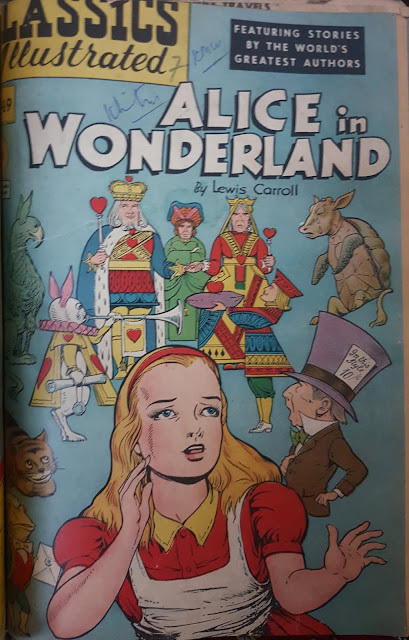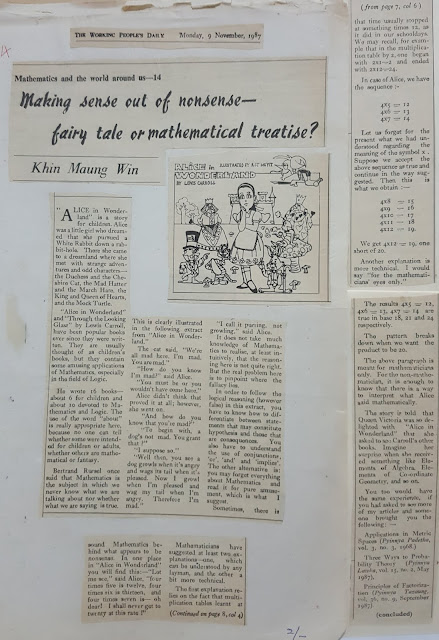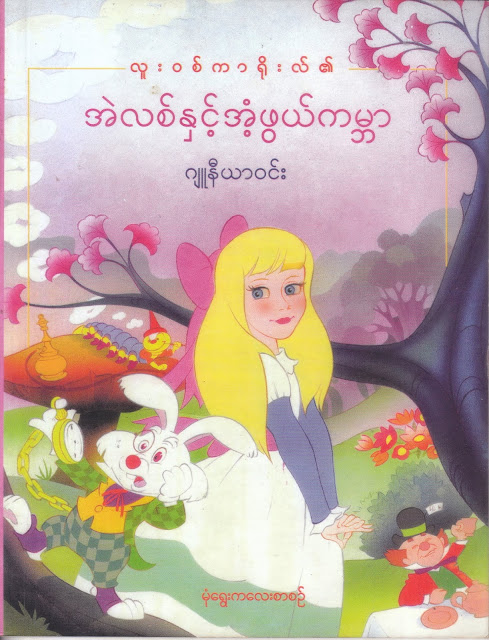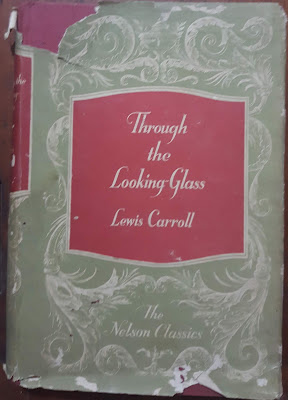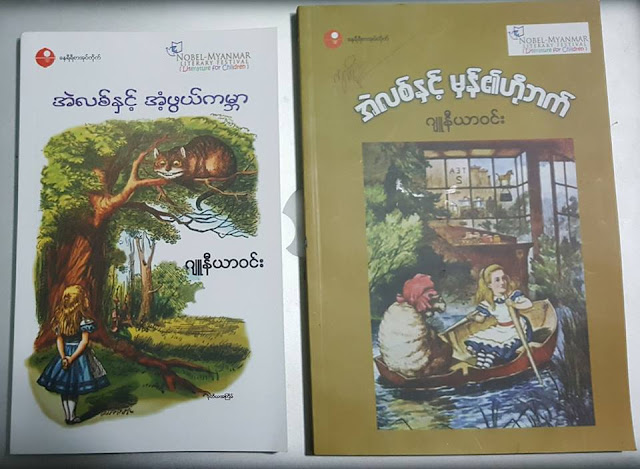The
Adventure of My Translating Lewis Carroll’s Masterpieces into Burmese
Adventure of My Translating Lewis Carroll’s Masterpieces into Burmese
In my childhood, I was familiar with
the story of Lewis Carroll’s ‘Alice in Wonderland’ by reading the Illustrated Classics,
and by watching Walt Disney’s Alice in Wonderland based on Alice books of Lewis
Carroll, little knowing that one day I would become a writer, and would be able
to read the original book of Lewis Carroll’s ‘Alice in Wonderland’, and
translate it into Burmese.
the story of Lewis Carroll’s ‘Alice in Wonderland’ by reading the Illustrated Classics,
and by watching Walt Disney’s Alice in Wonderland based on Alice books of Lewis
Carroll, little knowing that one day I would become a writer, and would be able
to read the original book of Lewis Carroll’s ‘Alice in Wonderland’, and
translate it into Burmese.
(‘Alice in Wonderland’ Classis
Illustrated that my father used to read when he was 5 years old.)
Illustrated that my father used to read when he was 5 years old.)
When I began to read the original book
of Lewis Carroll’s ‘Alice in Wonderland’, I already had the Master degree, and was
already a writer. I liked, and enjoyed the book very much. I asked my father
whether it was already translated into Burmese. It was not. My father (a
mathematics professor) also said that some logic, and philosophical terms in
the story were difficult to explain if you are not a mathematician. But he
encouraged me to translate the book into Burmese.
of Lewis Carroll’s ‘Alice in Wonderland’, I already had the Master degree, and was
already a writer. I liked, and enjoyed the book very much. I asked my father
whether it was already translated into Burmese. It was not. My father (a
mathematics professor) also said that some logic, and philosophical terms in
the story were difficult to explain if you are not a mathematician. But he
encouraged me to translate the book into Burmese.
(‘Alice’s Adventure in Wonderland,
Lewis Carroll’s original book (since 1900, The Nelson Classics) that I read in
2005.)
Lewis Carroll’s original book (since 1900, The Nelson Classics) that I read in
2005.)
My father, Dr. Khin Maung Win was
also a writer, and wrote serial articles in The
Working People’s Daily newspaper in 1987. Among them was Mathematics and the World Around Us –
‘Making Sense out of Nonsense- Fairy Tale or Mathematical Treatise?’ on
which you will find his mathematical point of view on the Lewis Carroll’s
‘Alice in Wonderland’ and ‘Through the Looking Glass’.
also a writer, and wrote serial articles in The
Working People’s Daily newspaper in 1987. Among them was Mathematics and the World Around Us –
‘Making Sense out of Nonsense- Fairy Tale or Mathematical Treatise?’ on
which you will find his mathematical point of view on the Lewis Carroll’s
‘Alice in Wonderland’ and ‘Through the Looking Glass’.
(The pieces from The Working People’s Daily newspaper on
9, November 1987, an article written by my father, and the drawing of Alice by
my twin brother, Maung Yit.)
9, November 1987, an article written by my father, and the drawing of Alice by
my twin brother, Maung Yit.)
Better known under the pen name
Lewis Carroll, Charles Lutwidge Dodgson, said my father, Dodgson was not only
an English writer, but also a professor of mathematics at Oxford University,
and also a logician, and philosopher. If you want to translate his book, you
should have the writing skill, as well as the knowledge of mathematics, and the
ability of the language know-how. My grandfather taught me English, and I
obtained my master degree in Mathematics, and I inherited the writing skill
from my grandmother (Khin Myo Chit). So I would be perfect to translate ‘Alice
in Wonderland’. Most important of all; -
I really like this book, and I was happy to translate it.
Lewis Carroll, Charles Lutwidge Dodgson, said my father, Dodgson was not only
an English writer, but also a professor of mathematics at Oxford University,
and also a logician, and philosopher. If you want to translate his book, you
should have the writing skill, as well as the knowledge of mathematics, and the
ability of the language know-how. My grandfather taught me English, and I
obtained my master degree in Mathematics, and I inherited the writing skill
from my grandmother (Khin Myo Chit). So I would be perfect to translate ‘Alice
in Wonderland’. Most important of all; -
I really like this book, and I was happy to translate it.
During my translation, I watched the
movie again, and again, and also reread the illustrated classic. I did not know
why some characters (such as Tweedledum & Tweedledee, etc) shown in the
movie are not found in the Lewis Carroll’s ‘Alice in Wonderland’. I thought
they were Walt Disney’s creations. I copied the song ‘Unbirthday’ from the
movie, and wrote about it in my preface. I used the drawing of a pair of ‘Alice,
and a mouse’ from the old Illustrated Classics, the original drawings of John
Tenniel from the Wikipedia, and the self-portrait of Lewis Carroll found in French
Literature book, ‘Les Paroles de Lewis Carroll’. My father wrote a short
biography of Lewis Carroll, and John Tenniel for me.
movie again, and again, and also reread the illustrated classic. I did not know
why some characters (such as Tweedledum & Tweedledee, etc) shown in the
movie are not found in the Lewis Carroll’s ‘Alice in Wonderland’. I thought
they were Walt Disney’s creations. I copied the song ‘Unbirthday’ from the
movie, and wrote about it in my preface. I used the drawing of a pair of ‘Alice,
and a mouse’ from the old Illustrated Classics, the original drawings of John
Tenniel from the Wikipedia, and the self-portrait of Lewis Carroll found in French
Literature book, ‘Les Paroles de Lewis Carroll’. My father wrote a short
biography of Lewis Carroll, and John Tenniel for me.
(A copy of the drawing of ‘Alice and
a mouse’ in the Classics Illustration (left), and my translation of that part of the story (right). Illustrated by Alex A.Blum.)
a mouse’ in the Classics Illustration (left), and my translation of that part of the story (right). Illustrated by Alex A.Blum.)
(The cover of ‘Lewis Carroll’s Alice
in Wonderland’ in Burmese released in 2006.) (The picture used there, was the illustration
from the movie Walt Disney. It was Ko Tar’s hard work. He wanted to show the
beautiful, and colorful cover.)
in Wonderland’ in Burmese released in 2006.) (The picture used there, was the illustration
from the movie Walt Disney. It was Ko Tar’s hard work. He wanted to show the
beautiful, and colorful cover.)
Ko Tar (publisher, and writer) was interested
in my book. He also suggested my father to translate ‘Alice in Wonderland’ into
Burmese. Now, he was happy to publish it. After ‘Alice in Wonderland’ in
Burmese was published in 2006, I started to read Lewis Carroll’s ‘Alice Through
the Looking Glass’. The characters missing in ‘Alice in Wonderland’, and the
meaning of ‘unbirthday’ were found in the book ‘Through the Looking Glass’. I decided
to translate it into Burmese. I liked it, that’s why I wanted to translate it.
But the first publisher, Ko Tar could not publish it because of his
difficulties. He returned the manuscript to me. But I could not find a publisher
who was willing to publish my book so far. I kept it in my desk for some years.
In 2008, my translated book, ‘Alice in Wonderland’ was awarded for the Children
Literary genre from the Htun Foundation.
in my book. He also suggested my father to translate ‘Alice in Wonderland’ into
Burmese. Now, he was happy to publish it. After ‘Alice in Wonderland’ in
Burmese was published in 2006, I started to read Lewis Carroll’s ‘Alice Through
the Looking Glass’. The characters missing in ‘Alice in Wonderland’, and the
meaning of ‘unbirthday’ were found in the book ‘Through the Looking Glass’. I decided
to translate it into Burmese. I liked it, that’s why I wanted to translate it.
But the first publisher, Ko Tar could not publish it because of his
difficulties. He returned the manuscript to me. But I could not find a publisher
who was willing to publish my book so far. I kept it in my desk for some years.
In 2008, my translated book, ‘Alice in Wonderland’ was awarded for the Children
Literary genre from the Htun Foundation.
(‘Lewis Carroll’s Through The
Looking Glass’ (since 1900, The Nelson Classics) that I read in 2009.)
Looking Glass’ (since 1900, The Nelson Classics) that I read in 2009.)
(I received gold medal for ‘Alice in
Wonderland’ in Burmese translation in 2008.)
Wonderland’ in Burmese translation in 2008.)
Later, my brother advised me to
publish ‘Alice Through the Looking Glass’ in Burmese as Kindle ebook before it would
be misplaced. That’s sound great! It might not be lost as long as Kindle lived!
In 2014, my translation of Lewis Carroll’s ‘Alice Through The Looking Glass’ in
Burmese appeared as ebook at Amazon. It would rest in peace for the rest of its
life.
publish ‘Alice Through the Looking Glass’ in Burmese as Kindle ebook before it would
be misplaced. That’s sound great! It might not be lost as long as Kindle lived!
In 2014, my translation of Lewis Carroll’s ‘Alice Through The Looking Glass’ in
Burmese appeared as ebook at Amazon. It would rest in peace for the rest of its
life.
(The cover of my ebook, ‘Alice
Through the Looking Glass’ that I designed in 2014.)
Through the Looking Glass’ that I designed in 2014.)
(Here is
the link,
the link,
When the time came to celebrate the Nobel
Myanmar Children Literary Festival in Rangoon in 2016, it attracted all our
publishers. Among the sections celebrated for the Children Literary Festival, the
first section showed a hundred different children books on a central desk. Hopefully,
the audience would pay a great deal of attention to them. Most of publishers in
Burma grasped this opportunity. They rushed to prepare Children books (old or
new) to publish on time. One of publishers contacted me, and asked me whether I
had written a children’s book ready to publish. Then my translated book ‘Alice
Through the Looking Glass’, and my first translated book of ‘Alice in
Wonderland’ as second edition came to join the hundred children books.
Myanmar Children Literary Festival in Rangoon in 2016, it attracted all our
publishers. Among the sections celebrated for the Children Literary Festival, the
first section showed a hundred different children books on a central desk. Hopefully,
the audience would pay a great deal of attention to them. Most of publishers in
Burma grasped this opportunity. They rushed to prepare Children books (old or
new) to publish on time. One of publishers contacted me, and asked me whether I
had written a children’s book ready to publish. Then my translated book ‘Alice
Through the Looking Glass’, and my first translated book of ‘Alice in
Wonderland’ as second edition came to join the hundred children books.
(‘Alice in Wonderland’ second
edition, and ‘Through the Looking Glass’ in Burmese published in 2016.)
edition, and ‘Through the Looking Glass’ in Burmese published in 2016.)
2 years later in 2018, Kazumi Goto,
a Professor Emeritus of Hosei University, one of the founder members of Lewis
Carroll Society of Japan, became interested in my translation of ‘Alice Through
the Looking Glass’ at Amazon Kindle. His student contacted me, and was looking
for my translation in print on the part of his professor. I was surprised, and as
well as pleased for hearing their interest of my books. I came to learn that they
admired not only the works of Lewis Carroll’s Masterpieces, but also were
interested in the translations of Alice around the world.
a Professor Emeritus of Hosei University, one of the founder members of Lewis
Carroll Society of Japan, became interested in my translation of ‘Alice Through
the Looking Glass’ at Amazon Kindle. His student contacted me, and was looking
for my translation in print on the part of his professor. I was surprised, and as
well as pleased for hearing their interest of my books. I came to learn that they
admired not only the works of Lewis Carroll’s Masterpieces, but also were
interested in the translations of Alice around the world.
My brother suggested that I should
have my translation of ‘Alice in Wonderland’ in Burmese published at Amazon
too. I chose the first edition of it.
have my translation of ‘Alice in Wonderland’ in Burmese published at Amazon
too. I chose the first edition of it.
(The link of my ebook in Amazon
Kindle. https://www.amazon.com/dp/B07DL9XY39/ref=mp_s_a_1_26?ie=UTF8&qid=1528700510&sr=8-26&pi=AC_SX236_SY340_FMwebp_QL65&keywords=moemaka
)
Kindle. https://www.amazon.com/dp/B07DL9XY39/ref=mp_s_a_1_26?ie=UTF8&qid=1528700510&sr=8-26&pi=AC_SX236_SY340_FMwebp_QL65&keywords=moemaka
)
Lewis Carroll (January 1832 – January
1898) published ‘Alice in Wonderland’ in1865, ‘Through the Looking Glass’ in
1871. His other books were about mathematics such as Algebra, Geometry, etc. Here,
I honored him by writing this article for the 186th Anniversary of
Lewis Carroll, 120th Anniversary of Lewis Carroll passing, 153rd
of ‘Alice in Wonderland’, and 157th of ‘Through the Looking Glass’ for
the year 2018.
1898) published ‘Alice in Wonderland’ in1865, ‘Through the Looking Glass’ in
1871. His other books were about mathematics such as Algebra, Geometry, etc. Here,
I honored him by writing this article for the 186th Anniversary of
Lewis Carroll, 120th Anniversary of Lewis Carroll passing, 153rd
of ‘Alice in Wonderland’, and 157th of ‘Through the Looking Glass’ for
the year 2018.
Long Live Lewis Carroll!

